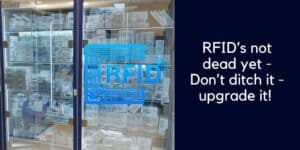What’s inside:
Does your implant tracking system provide the end to end tracking and robust data that you need to manage medical inventory effectively?
It’s time to look at the role of technology in plugging implant data gaps and boosting healthcare efficiency.
As the old song goes, ‘It Takes TWO, Baby’.
Over the last few years hospitals have seen the benefits of investing in RFID cabinets as an implant tracking system, ensuring the accurate management of medical devices, tissue, bone, and implants.
But many are missing a trick.
They may think their problems are solved by introducing a smart cabinet for medical device, tissue and implant storage – but all too often, after an item is removed for usage, the trail goes cold.
Once in the surgical setting, item tracking often goes by the wayside, falling into the hospital’s black hole – where there is $7.7 billion lost income a year.
That’s why it takes TWO.
Let’s take a look at how TWO complementary solutions
can provide robust medical device, tissue and implant tracking,
including the weakest link in the chain
– the point of care.
Why is an implant tracking system so important?
Medical device inventory management is seen as a key area for improvement by healthcare organizations, who are endeavoring to operate more efficiently as supply costs continue to rise.
There’s nothing new when it comes to the reasons why medical devices and implants need to be tracked, it’s the same issues hospital managers have been aware of for years:
- Compliance and patient safety – the digital tracking of UDI data is a regulatory requirement designed to protect patients – effective mechanisms to manage expiry and recall issues lower risk.
- Balanced inventory –visibility supports accurate restocking – preventing stock outs and surpluses
- Cost savings – organizations are looking for a leaner supply chain and optimum vendor arrangements
- Wastage – product wastage is coming under increased scrutiny, including surplus stock and the unnecessary expiry of unused products left sitting on the shelves.
- Reimbursement – there is renewed awareness of current system failures in the capture of chargeable items at POU.
Solution 1: RFID Cabinet for better inventory management
The first part of the implant tracking system is visibility.
RFID Technology is now the mainstay behind modern implant storage cabinets, resulting in the automatic tracking of implants, tissue and medical devices. Hospitals and surgery centers that have installed high quality RFID cabinets can now accurately monitor, track and reorder their stock, manage expiry and ensure UDI compliance.
However, these systems can only track what enters and leaves the cabinet.
Can it be assumed that every item taken from the cabinet is used?
And if an item is used in surgery, how is it recorded against the patient?
What about trunk items that arrive directly into the surgery setting, having by-passed hospital systems?
It seems that RFID Cabinets play an important part in inventory management but that they have limitations too. So how can hospitals make their medical device, tissue tracking management and implant inventory management systems more robust?
Solution 2: Point of Use Supply Capture
The missing link in the chain is an effective system at the point of use.
Most healthcare organizations do have a implant tracking system in place. The problem is, it is time consuming to use and stumbles when trunk stock and other tricky items come into the picture.
The surgery setting is so frantic, and spending time barcode scanning each individual item, dealing manually with products that bring up system errors and trying to get trunk stock onto the system, can just be too much for busy nurses, who need to focus on supporting the clinical team and the patient.
That’s why 52% of items used in the OR setting go unreported.
The unfortunate reality is that recording item usage at the POU is not consistently achieved and this will have implications on patient safety, hospital compliance and the billing revenue cycle.

The ideal combination is an implant tracking system that includes POU data capture
When you find an ideal pairing, you realize that the combination of both is greater than the sum of its parts.
Well, that’s how it is with IDENTI’s Total Sense Cabinet and Snap& Go solutions.
Total Sense Cabinet is an enhanced RFID solution allowing the storage of items at any angle, as well as different cabinet configurations. The cabinets automatically manage medical devices, tissues and implants and work in conjunction with the IDENTI management system to provide real-time tracking, expiry management and data insights.
Total Sense works great alongside Snap & Go – a POC data capture solution that uses image recognition to take a ‘snap’ of product packaging, achieving full charting in just 3 seconds. Snap & Go can capture all types of products – including trunk stock not already on the system and even a digital capture of your hand-written Count Sheets!
Both of these products can be used on their own, but the fact is that together they are formidable!
Total Sense and Snap & Go integrate with hospital systems and work together to strengthen your supply chain – replacing weak links with easy to use, workable solutions.
Put an end to your lost implant revenue. Discover why it takes TWO. Get a demo of our robust implant tracking system – find out more.






